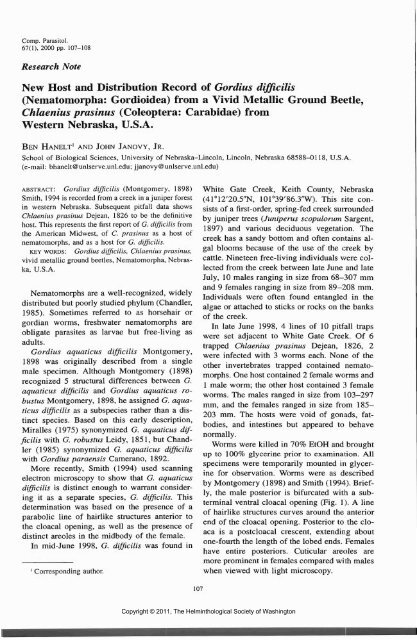Comparative Parasitology 67(1) 2000 - Peru State College
Comparative Parasitology 67(1) 2000 - Peru State College
Comparative Parasitology 67(1) 2000 - Peru State College
Create successful ePaper yourself
Turn your PDF publications into a flip-book with our unique Google optimized e-Paper software.
Comp. Parasitol.<br />
<strong>67</strong>(1), <strong>2000</strong> pp. 107-108<br />
Research Note<br />
New Host and Distribution Record of Gordius difficilis<br />
(Nematomorpha: Gordioidea) from a Vivid Metallic Ground Beetle,<br />
Chlaenius prasinus (Coleoptera: Carabidae) from<br />
Western Nebraska, U.S.A.<br />
BEN HANELT' AND JOHN JANOVY, JR.<br />
School of Biological Sciences, University of Nebraska-Lincoln, Lincoln, Nebraska 68588-0118, U.S.A.<br />
(e-mail: bhanelt@unlserve.unl.edu; jjanovy@unlserve.unl.edu)<br />
ABSTRACT: Gordius difficilis (Montgomery, 1898)<br />
Smith, 1994 is recorded from a creek in a juniper forest<br />
in western Nebraska. Subsequent pitfall data shows<br />
Chlaenius prasinus Dejean, 1826 to be the definitive<br />
host. This represents the first report of G. difficilis from<br />
the American Midwest, of C. prasinus as a host of<br />
nematomorphs, and as a host for G. difficilis.<br />
KEY WORDS: Gordius difficilis, Chlaenius prasinus,<br />
vivid metallic ground beetles, Nematomorpha, Nebraska,<br />
U.S.A.<br />
Nematomorphs are a well-recognized, widely<br />
distributed but poorly studied phylum (Chandler,<br />
1985). Sometimes referred to as horsehair or<br />
gordian worms, freshwater nematomorphs are<br />
obligate parasites as larvae but free-living as<br />
adults.<br />
Gordius aquaticus difficilis Montgomery,<br />
1898 was originally described from a single<br />
male specimen. Although Montgomery (1898)<br />
recognized 5 structural differences between G.<br />
aquaticus difficilis and Gordius aquaticus robustus<br />
Montgomery, 1898, he assigned G. aquaticus<br />
difficilis as a subspecies rather than a distinct<br />
species. Based on this early description,<br />
Miralles (1975) synonymized G. aquaticus difficilis<br />
with G. robustus Leidy, 1851, but Chandler<br />
(1985) synonymized G. aquaticus difficilis<br />
with Gordius paraensis Camerano, 1892.<br />
More recently, Smith (1994) used scanning<br />
electron microscopy to show that G. aquaticus<br />
difficilis is distinct enough to warrant considering<br />
it as a separate species, G. difficilis. This<br />
determination was based on the presence of a<br />
parabolic line of hairlike structures anterior to<br />
the cloacal opening, as well as the presence of<br />
distinct areoles in the midbody of the female.<br />
In mid-June 1998, G. difficilis was found in<br />
1 Corresponding author.<br />
107<br />
White Gate Creek, Keith County, Nebraska<br />
(41°12'20.5"N, 101°39'86.3"W). This site consists<br />
of a first-order, spring-fed creek suirounded<br />
by juniper trees (Juniperus scopulorum Sargent,<br />
1897) and various deciduous vegetation. The<br />
creek has a sandy bottom and often contains algal<br />
blooms because of the use of the creek by<br />
cattle. Nineteen free-living individuals were collected<br />
from the creek between late June and late<br />
July, 10 males ranging in size from 68-307 mm<br />
and 9 females ranging in size from 89-208 mm.<br />
Individuals were often found entangled in the<br />
algae or attached to sticks or rocks on the banks<br />
of the creek.<br />
In late June 1998, 4 lines of 10 pitfall traps<br />
were set adjacent to White Gate Creek. Of 6<br />
trapped Chlaenius prasinus Dejean, 1826, 2<br />
were infected with 3 worms each. None of the<br />
other invertebrates trapped contained nematomorphs.<br />
One host contained 2 female worms and<br />
1 male worm; the other host contained 3 female<br />
worms. The males ranged in size from 103-297<br />
mm, and the females ranged in size from 185-<br />
203 mm. The hosts were void of gonads, fatbodies,<br />
and intestines but appeared to behave<br />
normally.<br />
Worms were killed in 70% EtOH and brought<br />
up to 100% glycerine prior to examination. All<br />
specimens were temporarily mounted in glycerine<br />
for observation. Worms were as described<br />
by Montgomery (1898) and Smith (1994). Briefly,<br />
the male posterior is bifurcated with a subterminal<br />
ventral cloacal opening (Fig. 1). A line<br />
of hairlike structures curves around the anterior<br />
end of the cloacal opening. Posterior to the cloaca<br />
is a postcloacal crescent, extending about<br />
one-fourth the length of the lobed ends. Females<br />
have entire posteriors. Cuticular areoles are<br />
more prominent in females compared with males<br />
when viewed with light microscopy.<br />
Copyright © 2011, The Helminthological Society of Washington
















